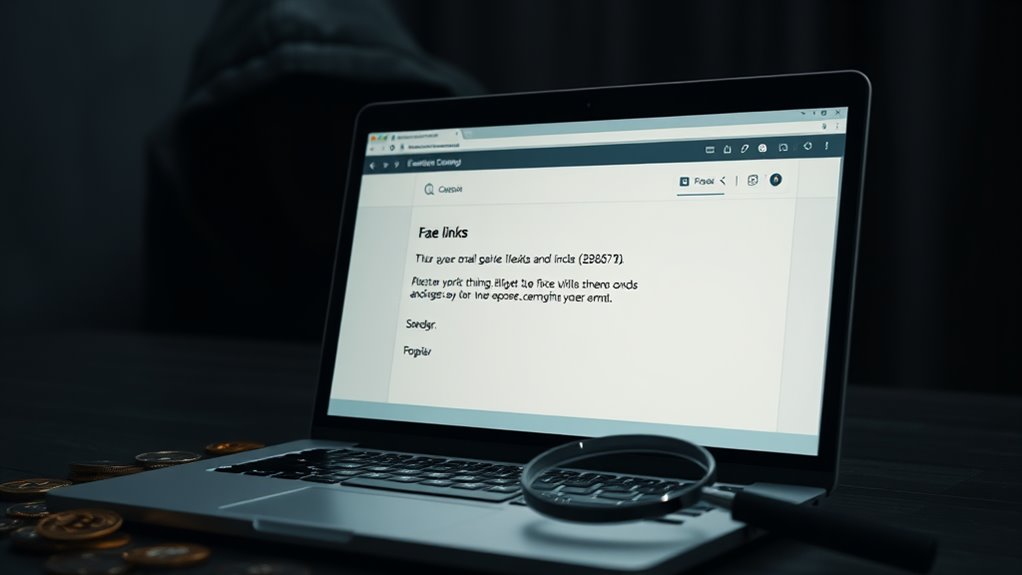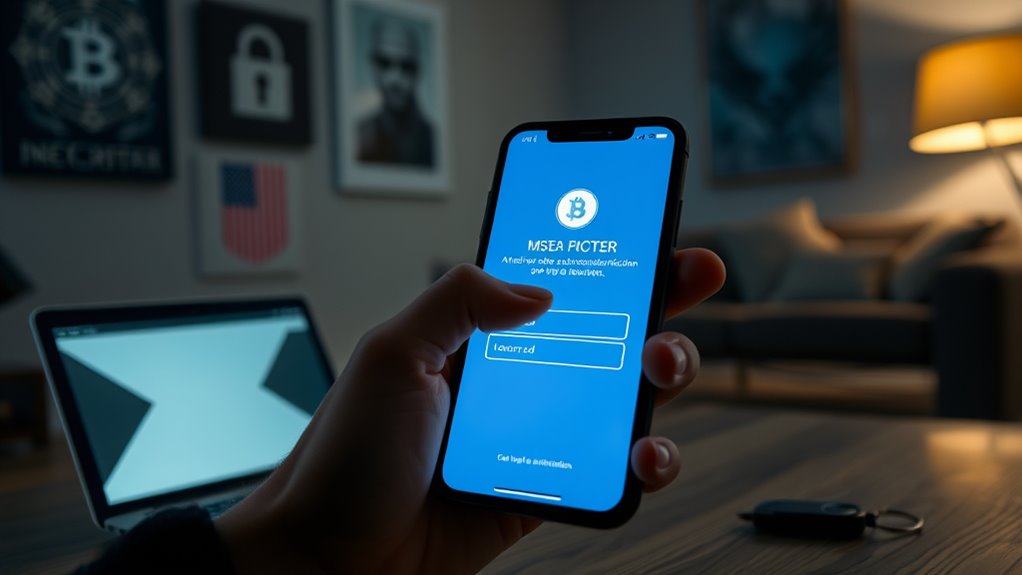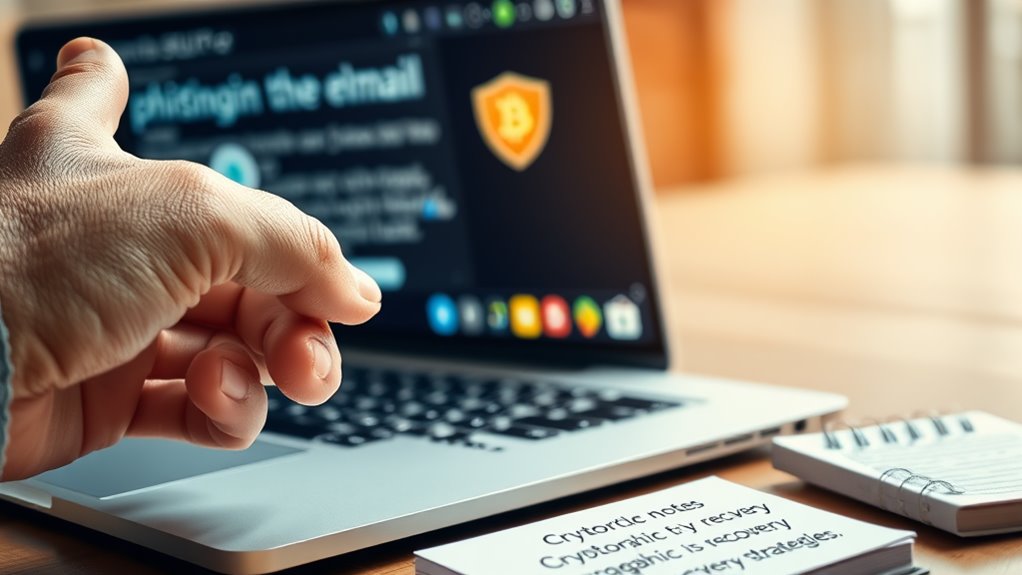
How to Recognize and Avoid Phishing Attacks: Top Tips for Crypto Safety
Recognizing crypto phishing attacks requires vigilance for red flags like urgent demands, unprofessional language, and vague contact information. Users should implement multi-factor authentication, use hardware wallets for offline storage, and verify recipient addresses before transactions. Never click suspicious links or share private keys. Transaction verification through small test amounts adds security. Secure networks are essential for safe crypto management. The following strategies offer extensive protection against increasingly sophisticated scam techniques.
Key Takeaways
- Verify website URLs carefully, checking for subtle misspellings or incorrect domain extensions before entering credentials.
- Enable multi-factor authentication on all cryptocurrency platforms, reducing phishing success rates by up to 99.9%.
- Be skeptical of communications creating urgency or offering unrealistic returns, as these are common phishing tactics.
- Use hardware wallets to store significant crypto assets offline, protecting them from online threats.
- Conduct small test transactions to verify recipient addresses before sending large amounts of cryptocurrency.
Understanding the Anatomy of Crypto Phishing Attacks

While digital currencies offer innovative financial opportunities, they have also created new avenues for cybercriminals to exploit unsuspecting users.
Crypto phishing attacks combine sophisticated technology with social engineering tactics to deceive cryptocurrency holders. These attacks typically feature convincing replicas of legitimate platforms, designed to steal wallet credentials or assets.
Perpetrators often create a sense of urgency, presenting scenarios that require immediate action without verification. Common strategies include bait-and-switch tactics involving fake transactions or NFT trades that trick users into revealing sensitive information.
The complexity of these attacks lies in their dual approach: exploiting both technical vulnerabilities and human psychology. Criminals carefully craft messages that appear authentic, making it challenging even for experienced users to distinguish between legitimate communications and fraudulent attempts. Additionally, being aware of common pitfalls like poorly written documents can help users stay vigilant against potential scams.
Red Flags: How to Spot Fraudulent Crypto Communications

Vigilance serves as the first line of defense against cryptocurrency scams that continue to evolve in sophistication. Recognizing suspicious communications can protect investors from potential fraud. Legitimate platforms maintain transparency, professional language, and clear contact information.
| Warning Sign | What to Look For | Action to Take |
|---|---|---|
| Communication Style | Urgent demands, unprofessional language, misspellings | Delete message, block sender |
| Contact Information | Missing or vague details, foreign phone numbers | Verify through official channels |
| Transaction Requests | Unusual payment methods, requests for personal data | Never share sensitive information |
Be wary of unsolicited offers arriving through email, social media, or messaging apps. Claims of guaranteed returns or instant wealth are almost always fraudulent. Phishing attempts often mimic legitimate services, so verify website URLs carefully before entering credentials. Additionally, being aware of rug pulls can help you recognize the broader range of scams in the crypto space.
Hardware and Software Security Essentials for Crypto Users

Protecting cryptocurrency investments requires both hardware and software security measures working in tandem.
Cold wallets serve as the first line of defense by storing crypto assets offline, away from internet-connected threats that plague hot wallets.
Implementing multi-factor authentication systems creates additional security layers, requiring multiple verification methods before transactions are approved, considerably reducing the risk of unauthorized access even if login credentials are compromised. Additionally, it is crucial to keep sensitive information such as private keys and seed phrases stored securely offline to minimize exposure to potential cyber threats.
Cold Wallet Protection
Most cryptocurrency investors face significant risks when storing digital assets online, making cold wallets an essential security measure against potential threats. These hardware devices store private keys offline, keeping them isolated from internet-connected systems where hackers typically operate.
Cold wallets employ robust security features including Secure Element chips that protect private keys from physical attacks and PIN protection to prevent unauthorized access. Many devices also feature tamper-evident designs that alert users to potential breaches.
For maximum protection, investors should purchase devices only from authorized retailers, use additional passphrase protection, and store recovery seed phrases in secure, separate locations. Regular firmware updates are vital for maintaining protection against emerging vulnerabilities, while air-gapped functionality in premium devices like COLDCARD provides enhanced security by ensuring complete isolation from online systems. Additionally, users should always verify transaction details on the wallet’s screen to prevent unauthorized transfers.
Multi-Factor Defense Systems
While cold wallets provide strong offline protection for cryptocurrency assets, an extensive security approach requires multiple layers of defense both online and offline.
Multi-factor authentication (MFA) represents a significant upgrade over traditional two-factor systems by incorporating three or more verification methods.
Effective multi-factor defense systems typically include:
- Hardware security tokens that generate one-time codes or require physical interaction
- Biometric verification through fingerprints, facial recognition, or voice identification
- Authenticator apps that produce time-based codes independent of SMS
- Regular security audits to identify and address potential vulnerabilities
These measures, when implemented together, create a robust defense against sophisticated phishing attempts.
Implementing multi-factor authentication significantly enhances security by requiring users to provide multiple verification methods before accessing their accounts.
Even if attackers compromise one authentication factor, the additional layers prevent unauthorized access to valuable crypto assets.
The Role of Multi-Factor Authentication in Preventing Unauthorized Access

Multi-factor authentication creates multiple security barriers that hackers must overcome to gain unauthorized access to cryptocurrency accounts.
Effective MFA implementation strategies include using hardware security keys, biometric verification, and time-based authentication codes from separate devices.
These layered security approaches can reduce the risk of successful phishing attacks by 99.9%, making MFA an essential component of any thorough crypto security plan. Additionally, incorporating encryption protocols into the MFA process further enhances the protection of user data against potential breaches.
Security Layers Explained
A robust defense against phishing attacks requires multiple layers of security working in tandem, with Multi-Factor Authentication (MFA) serving as a critical component.
MFA implements multiple verification methods beyond passwords, effectively blocking 99.9% of automated attacks by requiring additional proof of identity.
The security layers typically include:
- Knowledge factors – something you know (passwords, PINs)
- Possession factors – something you have (mobile authenticator apps, security keys)
- Inherence factors – something you are (fingerprints, facial recognition)
- Location factors – somewhere you are (geographic location verification)
Unlike Two-Factor Authentication (2FA), MFA can incorporate more than two verification methods, providing enhanced protection.
As cryptocurrency exchanges and wallets increasingly adopt these measures, users gain considerably stronger protection against unauthorized access attempts. Additionally, using a VPN for crypto security can further safeguard transactions by encrypting internet traffic and masking IP addresses.
MFA Implementation Strategies
Building upon the foundation of security layers, organizations must develop strategic approaches to implement MFA effectively across their systems.
Successful MFA deployment requires careful consideration of organizational needs, user demographics, and potential security threats.
A staged rollout approach allows organizations to identify and address challenges before full implementation. This should include thorough infrastructure preparation, guaranteeing software and hardware compatibility.
For maximum impact against phishing attacks, organizations should prioritize phishing-resistant methods such as FIDO2 standards, biometric authentication, and hardware security tokens, while avoiding vulnerable methods like SMS.
Adaptive MFA, which uses contextual information to adjust authentication requirements, can greatly reduce user friction.
Regular policy reviews and establishing a user feedback loop guarantee MFA strategies remain current and effective as security threats evolve.
Safe Transaction Practices When Managing Digital Assets

When conducting transactions with digital assets like cryptocurrency, maintaining secure practices becomes essential for protecting one’s investments from potential threats. Implementing proper security measures can greatly reduce vulnerability to attacks and unauthorized access.
The following practices help safeguard digital assets during transactions:
Implementing proper security protocols remains critical for protecting your cryptocurrency investments during every transaction phase.
- Only use secure, private networks when conducting cryptocurrency transactions; avoid public Wi-Fi and regularly update security software.
- Choose reputable wallets with strong encryption and two-factor authentication, and maintain secure backups.
- Verify recipient addresses with small test transactions before sending larger amounts.
- Monitor transactions in real-time and report any suspicious activity immediately to appropriate authorities.
Additionally, regularly educating oneself about common threats can further enhance your security strategy.
Understanding these practices helps users create a safer environment for managing digital assets while minimizing potential security risks.
Recovery Strategies for Compromised Crypto Accounts

Swift action becomes vital when cryptocurrency accounts face security breaches or unauthorized access.
Victims should immediately notify financial institutions, enhance security measures, and lock credit reports to prevent further damage. Gathering evidence through screenshots and transaction logs is essential for documentation.
Filing reports with the FBI’s Internet Crime Complaint Center establishes an official record, while engaging legal assistance strengthens potential arbitration claims.
Users should revoke malicious contract approvals using tools like Revoke.cash and track stolen funds via blockchain explorers. Additionally, securing any remaining assets by moving them to a secure hardware wallet is crucial for minimizing losses.
For long-term security, implementing two-factor authentication, transferring remaining assets to new hardware wallets with fresh seed phrases, and conducting thorough malware scans are essential steps.
Regular security updates and awareness of current phishing tactics help prevent future compromises.
Staying Ahead: Emerging Phishing Tactics in the Crypto Space

As cryptocurrency adoption grows worldwide, scammers continuously develop sophisticated phishing techniques to exploit unsuspecting investors. The latest tactics leverage advanced technology and psychological manipulation to appear increasingly legitimate.
Four emerging phishing strategies to watch for:
- AI-generated deepfakes impersonating celebrities or influencers to endorse fraudulent investment schemes.
- Malicious QR codes directing victims to convincing but fake exchanges designed to steal login credentials.
- Hijacked livestreams promoting false investment opportunities or fabricated token giveaways.
- “Pig-butchering” schemes on messaging apps like Telegram and WhatsApp, where scammers build relationships before introducing fraudulent investments.
These tactics often incorporate urgency and FOMO (fear of missing out) elements to pressure victims into making hasty decisions without proper verification, bypassing normal security precautions that would otherwise protect their assets. Additionally, users should be aware of crypto dusting attacks, which can further compromise their privacy and security in the crypto space.
Frequently Asked Questions
Can Phishing Attacks Bypass Hardware Wallets?
Phishing attacks cannot directly bypass hardware wallets’ security but can trick users into revealing recovery phrases. The wallet’s offline storage remains secure unless social engineering successfully extracts sensitive information from the user themselves.
Are Decentralized Exchanges Immune to Phishing Scams?
Decentralized exchanges are not immune to phishing scams. While their smart contract architecture reduces traditional phishing vectors, users remain vulnerable through compromised frontend interfaces, malicious wallet connections, and social engineering targeting private keys.
How Quickly Do Hackers Typically Drain Compromised Crypto Accounts?
Hackers typically drain compromised crypto accounts within minutes to hours after gaining access, using automated tools and pre-planned strategies to quickly transfer funds before victims become aware of the unauthorized activity.
Can Blockchain Analytics Help Recover Phished Crypto Assets?
Blockchain analytics can assist in recovering phished crypto assets by tracing transactions on public ledgers, identifying exchange deposits, and building evidence for legal interventions. However, successful recovery depends on quick action and jurisdictional cooperation.
Should I Use Different Wallets for Trading Versus Long-Term Storage?
Using different wallets for trading and long-term storage is advisable. Hot wallets facilitate frequent transactions but have security risks, while cold wallets offer offline security for storing larger amounts of cryptocurrency not actively traded.
Conclusion
Vigilance remains the cornerstone of crypto security in an ever-evolving digital landscape. As demonstrated in the 2020 Twitter Bitcoin scam, where hackers compromised high-profile accounts to solicit cryptocurrency transfers, even sophisticated users can fall victim to well-crafted attacks. By implementing the security measures outlined in this guide, crypto users can greatly reduce their vulnerability to phishing attempts and better protect their digital assets.












